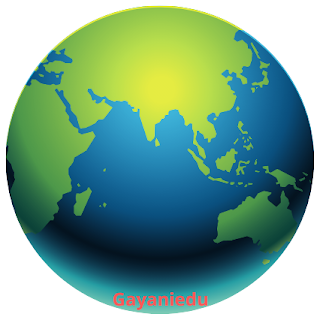WATER: A NATURAL RESOURCE
Hello reader, in this article we are going to study about following topics :-
- Water -a renewable Resources
- Shortage of Water
- How much water is available
- Forms of water
- Water Cycle
WATER –A RENEWABLE RESOURCE
Just have a look at the picture of Earth taken from space .you will find that it appears blue .Nearly 3/4th of the Earth‘s surface is covered with water .Water is found in the seas, rivers, oceans lakes and ponds. Under the ground, it is found in empty space between rocks A large quantity of water is present in glaciers and polar ice caps in the frozen from. It is also present in atmosphere in from of water vapour.
Water is
essential for life. All plants and animal need water to perform many activities
like:
·
Various
processes in our body such as, digestion of food, absorption of nutrients by
the body or getting rid of body wastes, need water.
·
2/3rd
of the human body is water.
·
We
drink water to maintain the body temperature. When this water evaporates from
the surface of body as sweat, it takes away heat from the body and gives
cooling effect.
·
In
plants, water is essential for germination of seeds, growth and photosynthesis.
It also helps in transporting nutrients from t he soil and the food from the
soil and the food from leaves to different parts of the plants.
·
Water
is used for cooking, washing clothes and also for generating electricity.
·
It
is also used in agriculture and industries.
·
It
is also used as a medium of transport.
·
Water
is a habitat for many plants and animals.
SHORTAGE OF WATER
Water is a natural and renewable resources, still we
face shortage of water. That is why; your parents and teachers advise you not
to waste water.
HOW MUCH WATER IS AVAILABLE?
· About 97.4% of the available water is found in seas
and oceans and cannot be used by us because of its high salt content.
·
2% of water is frozen in glaciers and in the polar ice
caps. That is fresh water, but it is not available to us.
·
So, only 0.6% of water is available for us as fresh
water. But, out of this, 0.59% is present as ground water and only 0.01% is
available as fresh water on the surface of the earth.
Look an
activity to know the availability of water
|
Steps |
Assumption |
Steps |
Assumption |
|
(i). Take a
medium size bucket. Fill it with water |
Imagine that
this water represents total water present on the earth. |
(ii). Take a
teaspoon of about 5 ml capacity and transfer 100 spoons of water from the
bucket to a mug. |
Assume that,
this represents total fresh water on the earth. |
|
(iii). Now,
from the mug transfer 30 spoons of water to a glass. |
This
represents usable water present as ground water. |
(iv).
Finally, take out 1/4th spoonful of water from the mug. |
This
represents all the water presents in all the lakes and rivers of the world. |
The water that is left behind in the bucket represents the
saline water presents in the seas and oceans.
The water left in the mug represents the water present in the
frozen from in glaciers and polar ice caps.
FORMS OF WATER
We know water can be found in three states, i.e. solid,
liquid, and gas. Ice, water and steam are the three states of water.
The solid form, snow and ice is found in glaciers and ice
caps on the poles. Liquid form of water is present in ocean, lakes, rivers, and
as underground sources. The gaseous form is the water vapour present in the
atmosphere.
The state of water can be changed by heating or cooling:
When ice is heated it change into water.
When water is heated. It change into vapour
When the water vapour cools down, it changes into water.
When water is cooled, it change into ice.
WATER CYCLE
We have studied the water cycle in class 6. The water in Seas, rivers, ponds or streams evaporate because of the heat of the sun, This water vapour rises up. High in the atmosphere, the vapour cools down to form drops of water. These drops of water combine together to form clouds.
When clouds become
too heavy, they fall on the Earth as rain. In colder regions, the water may
fall as hail or snow. The rainwater then drains into rivers and streams or seep
through the soil to form ground water.
This water again evaporates and the water cycle in nature goes on.
Final Thought :-
So, friends today in this article we learn many topics like :- Water -a renewable Resources, Shortage of Water, How much water is available on the earth, Forms of water, Water Cycle. if you think this article is nice then you can also share on social media with your friends.


